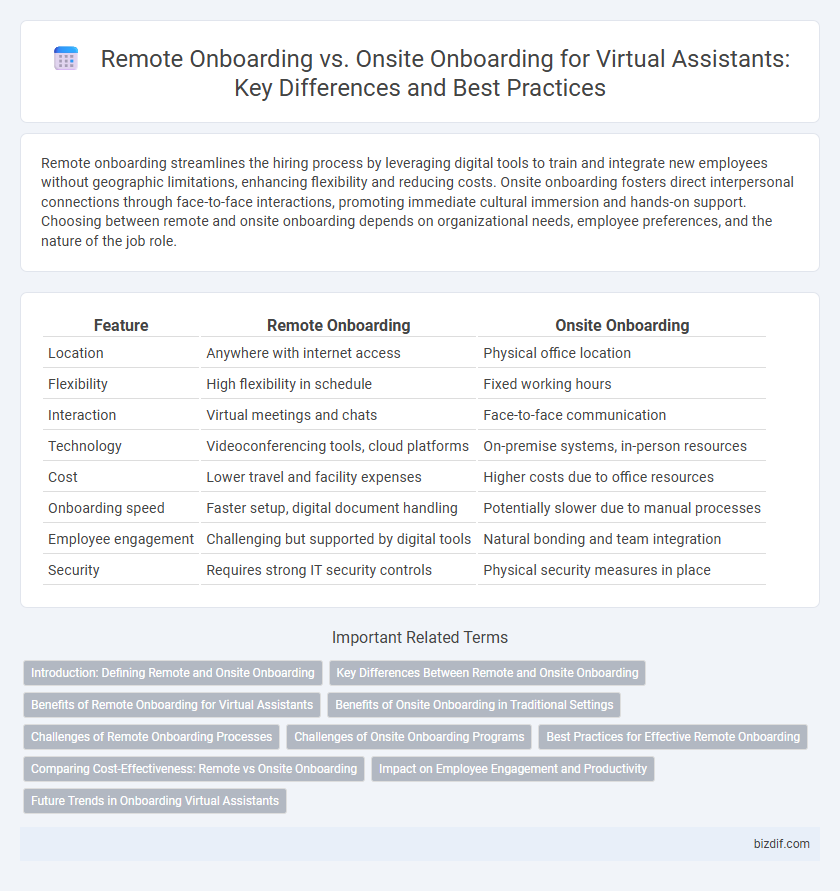Remote onboarding streamlines the hiring process by leveraging digital tools to train and integrate new employees without geographic limitations, enhancing flexibility and reducing costs. Onsite onboarding fosters direct interpersonal connections through face-to-face interactions, promoting immediate cultural immersion and hands-on support. Choosing between remote and onsite onboarding depends on organizational needs, employee preferences, and the nature of the job role.
Table of Comparison
| Feature | Remote Onboarding | Onsite Onboarding |
|---|---|---|
| Location | Anywhere with internet access | Physical office location |
| Flexibility | High flexibility in schedule | Fixed working hours |
| Interaction | Virtual meetings and chats | Face-to-face communication |
| Technology | Videoconferencing tools, cloud platforms | On-premise systems, in-person resources |
| Cost | Lower travel and facility expenses | Higher costs due to office resources |
| Onboarding speed | Faster setup, digital document handling | Potentially slower due to manual processes |
| Employee engagement | Challenging but supported by digital tools | Natural bonding and team integration |
| Security | Requires strong IT security controls | Physical security measures in place |
Introduction: Defining Remote and Onsite Onboarding
Remote onboarding involves integrating new employees through digital platforms, enabling seamless access to company resources and training without physical presence, which enhances flexibility and accelerates productivity. Onsite onboarding requires new hires to participate in in-person orientation sessions, fostering direct interaction with team members and immediate immersion in the workplace culture. Both methods aim to ensure comprehensive employee integration but differ significantly in delivery and engagement approaches.
Key Differences Between Remote and Onsite Onboarding
Remote onboarding leverages digital tools and virtual communication platforms to integrate new hires, emphasizing flexibility and access regardless of location, whereas onsite onboarding involves face-to-face interactions and physical presence within the workplace to foster immediate team connections and hands-on training. Key differences include communication methods, with remote onboarding relying heavily on video calls and webinars, while onsite onboarding utilizes in-person meetings and direct supervision. Additionally, remote onboarding requires robust IT support and clear documentation, contrasting with onsite onboarding's emphasis on workplace familiarization and real-time feedback.
Benefits of Remote Onboarding for Virtual Assistants
Remote onboarding for virtual assistants enhances flexibility by allowing seamless integration into workflows without geographical constraints. It reduces costs related to travel and physical workspace while accelerating productivity through digital training tools and resources. This method fosters immediate access to global talent pools, ensuring a diverse and skilled virtual workforce.
Benefits of Onsite Onboarding in Traditional Settings
Onsite onboarding in traditional settings fosters immediate face-to-face interaction, which enhances communication and builds stronger team cohesion. New employees gain hands-on experience with office tools and environments, accelerating their integration and productivity. This approach also allows for direct supervision and real-time feedback, ensuring clearer understanding of roles and company culture.
Challenges of Remote Onboarding Processes
Remote onboarding presents unique challenges such as limited face-to-face interaction, which can hinder relationship building and cultural assimilation. Technical issues, including software compatibility and varying internet connectivity, often disrupt seamless training and communication. The lack of immediate access to on-site resources complicates hands-on learning and timely support during the initial onboarding phase.
Challenges of Onsite Onboarding Programs
Onsite onboarding programs often face challenges such as higher logistical costs, limited flexibility in scheduling, and difficulties accommodating remote or geographically dispersed employees. These programs can result in inconsistent training experiences due to varying instructor quality and resource availability across locations. Additionally, onsite onboarding may struggle with scalability and adapting quickly to organizational changes, impacting overall efficiency.
Best Practices for Effective Remote Onboarding
Effective remote onboarding requires clear communication protocols, interactive training modules, and regular virtual check-ins to ensure new hires feel connected and supported. Utilizing digital collaboration tools and providing comprehensive resource access facilitates seamless integration into company culture and workflows. Prioritizing personalized onboarding experiences and establishing measurable goals accelerates productivity and engagement for remote employees.
Comparing Cost-Effectiveness: Remote vs Onsite Onboarding
Remote onboarding significantly reduces costs by eliminating expenses related to office space, travel, and printed materials, making it a more budget-friendly option compared to onsite onboarding. Onsite onboarding often incurs higher costs due to facility usage, in-person training sessions, and logistical arrangements. Companies leveraging remote onboarding platforms can achieve similar or improved employee integration while optimizing overall onboarding expenditures.
Impact on Employee Engagement and Productivity
Remote onboarding leverages digital tools to enable flexible learning, often enhancing employee engagement through interactive virtual platforms and real-time collaboration. Onsite onboarding provides direct face-to-face interaction, fostering immediate team bonding and hands-on experience, which can boost productivity by accelerating acclimation to workplace culture. Studies reveal that combining remote and onsite onboarding elements optimizes overall engagement and sustains higher productivity levels in new hires.
Future Trends in Onboarding Virtual Assistants
Future trends in onboarding virtual assistants emphasize remote onboarding driven by advancements in AI-powered communication tools and cloud-based training platforms that enhance accessibility and scalability. Remote onboarding offers ongoing virtual collaboration, real-time feedback, and personalized learning modules, reducing costs and improving productivity compared to traditional onsite methods. Increasing integration of augmented reality (AR) and virtual reality (VR) environments promises immersive onboarding experiences, facilitating faster adaptation and deeper engagement for remote virtual assistants.
Remote onboarding vs Onsite onboarding Infographic

 bizdif.com
bizdif.com